
Ephippidae is a family of percomorph fishes, the spadefishes, in the order Moroniformes. These fishes are found in the tropical and temperate oceans of the world, except for the central Pacific.
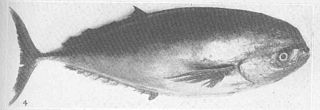
The louvar or luvar is a species of marine ray-finned fish, it is the only extant species in the genus Luvarus and family Luvaridae. This taxon is classified within the suborder Acanthuroidei, which includes the surgeonfish, of the order Acanthuriformes. The juvenile form has a pair of spines near the base of the tail, like the surgeonfish, though they are lost in the adult.
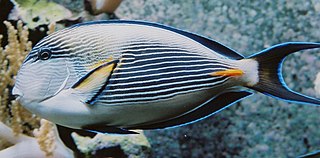
The sohal surgeonfish or sohal tang, is a species of marine ray-finned fish belonging to the family Acanthuridae, which includes the surgeonfishes, unicornfishes and tangs. This fish is found in the northwestern Indian Ocean.

Macolor is a genus of marine ray-finned fish, snappers belonging to the family Lutjanidae. They are native to the Indian Ocean and the western Pacific Ocean.

The black and white snapper, the black and white seaperch or black snapper, is a species of marine ray-finned fish, a snapper belonging to the family Lutjanidae. It is native to the Indian Ocean and the western Pacific Ocean.

Scatophagus argus, the spotted scat, butterfish, mia mia, spotted butterfish or tiger scat, is a species of fish in the scat family Scatophagidae. It occurs in two basic color morphs which are called green scat and ruby or red scat. This fish is generally distributed around the Indo-Pacific region, to Japan, New Guinea, and southeastern Australia. They live in coastal muddy areas, including estuaries, mangroves, harbours, and the lower courses of rivers. They are popular aquarium fish.

The Atlantic spadefish is a species of marine ray-finned fish belonging to the family Ephippidae, the spadefishes. It is the symbol of the North Carolina Aquariums.
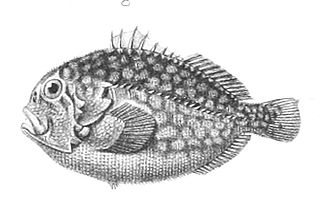
Caracanthus, the coral crouchers, or orbicular velvetfishes, are a genus of ray-finned fishes. They live in coral reefs of the tropical Indo-Pacific. This genus is the only member of the monotypic subfamily Caracanthinae, part of the family Scorpaenidae.
Platax pinnatus, also known as the longfin batfish, pinnate spadefish, pinnate batfish, pinnatus batfish, dusky batfish, shaded batfish, or red-faced batfish is a species of marine ray-finned fish belonging to the family Ephippidae, the spadefishes and batfishes. This species is found in the western Pacific Ocean and occasionally is kept in marine aquariums.
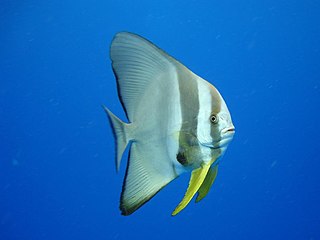
Platax teira, also known as the teira batfish, longfin batfish, longfin spadefish, or round faced batfish is a species of marine ray-finned fish belonging to the family Ephippidae, the spadefishes and batfishes. This species is found in the Indo-West Pacific.

Acanthurus maculiceps, the white-freckled surgeonfish, yellow-freckled surgeonfish, pale-lined surgeonfish,spotted-faced surgeonfish or earbar surgeonfish, is a species of marine ray-finned fish belonging to the family Acanthuridae, the surgeonfishes, unicornfishes and tangs. This species is found in the Indo-West Pacific region.
Acanthurus reversus is a species of marine ray-finned fish belonging to the family Acanthuridae, which includes the surgeonfishes, unicornfishes and tangs. This fish is endemic to French Polynesia.

Chaetodipterus is a genus of marine ray-finned fishes belonging to the family Ephippidae, the spadefishes. These fishes are found in the Atlantic and eastern Pacific Oceans.
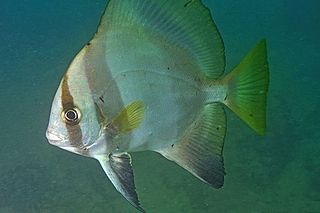
Platax batavianus, the humpback batfish, Batavian batfish, batfish, humped batfish, hump-headed hatfish, moonfish or zebra batfish, is a species of marine ray-finned fish in the family Ephippidae, the spadefishes and batfishes. They are found in coral reefs around the Indo-Pacific region. Adults can grow up to 65 centimetres (26 in) at maximum.

The spotbanded scat,(Selenotoca multifasciata), also known as the striped scat, banded scat, barred scat, butterfish, John Dory, Johnny Dory, old maid, Southern butter-fish or striped butterfish, is a species of ray-finned fish, belonging to the family Scatophagidae, the scats. They are found in the eastern Indian Ocean and southwestern Pacific Ocean.

Pomadasys argenteus, the silver grunt, silver javelin, grunter bream, small-spotted grunter-bream, small-spotted javelin fish, trumpeter or white-finned javelin fish, is a species of marine ray-finned fish, a grunt from the family Haemulidae. This species has a wide Indo-Pacific distribution. It is the type species of the genus Pomadasys.
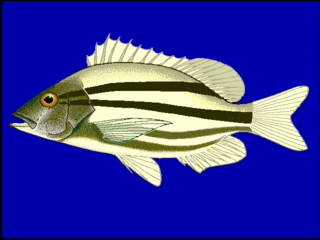
The pygmy snapper is a species of ray-finned fish, a snapper belonging to the family Lutjanidae. It is found in the western Pacific Ocean and is only known from fresh and brackish waters.
The black foxface is a species of marine ray-finned fish, a rabbitfish belonging to the family Siganidae. It is endemic to Tonga in the western Pacific Ocean.

Siganus stellatus, the brown-spotted spinefoot, brown-spotted rabbitfish, honeycomb rabbitfish, starspotted spinefoot, starspotted rabbitfish or stellate rabbitfish is a species of marine ray-finned fish, a rabbitfish belonging to the family Siganidae. It is found in the Indo-Pacific region.
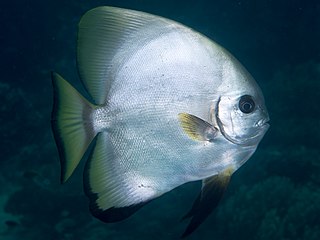
Platax boersii, the golden spadefish or Boers’ batfish, is a species of marine ray-finned fish belonging to the family Ephippidae, the spadefishes and bay fishes. This species is found in the Indo-West Pacific.

















